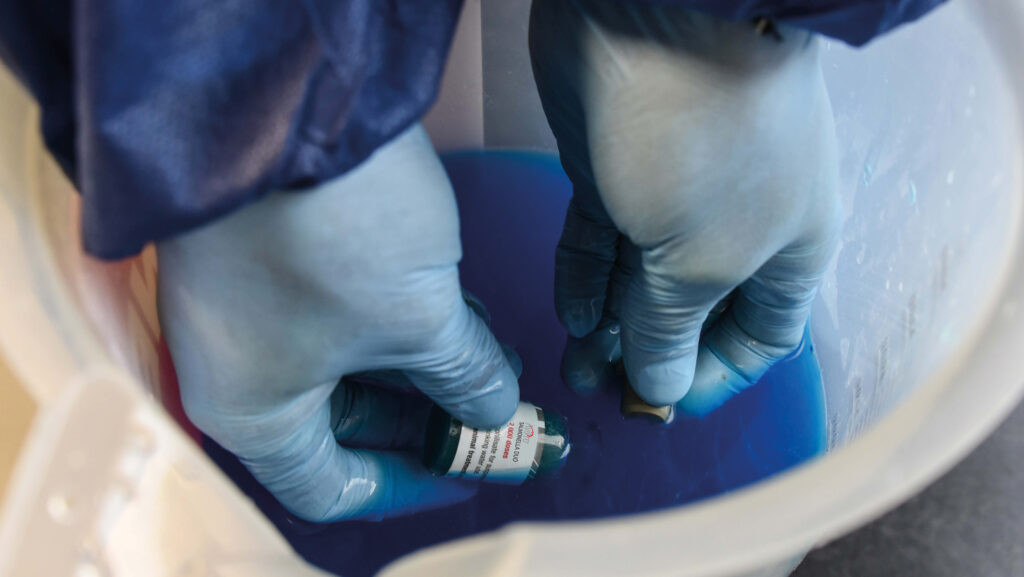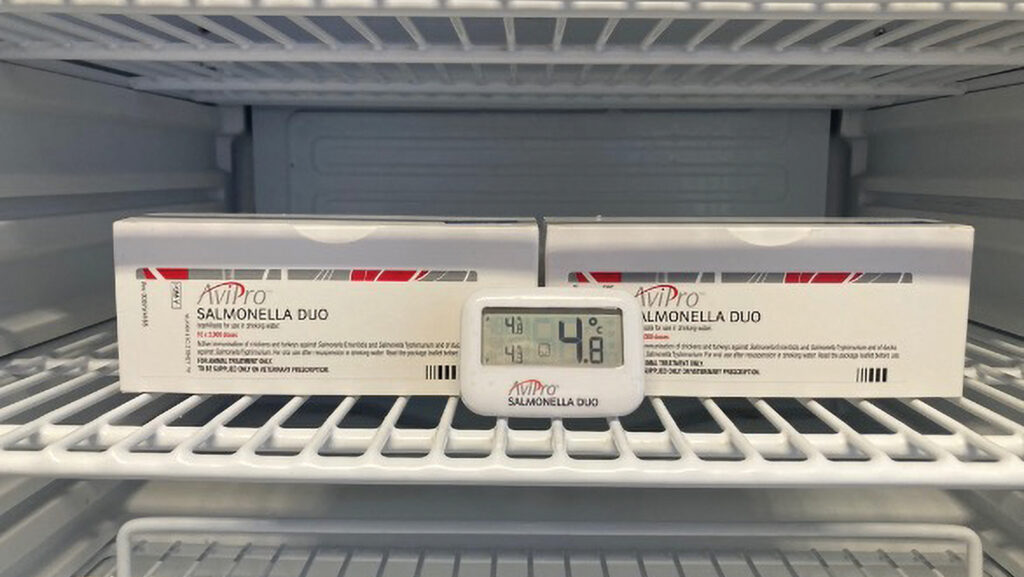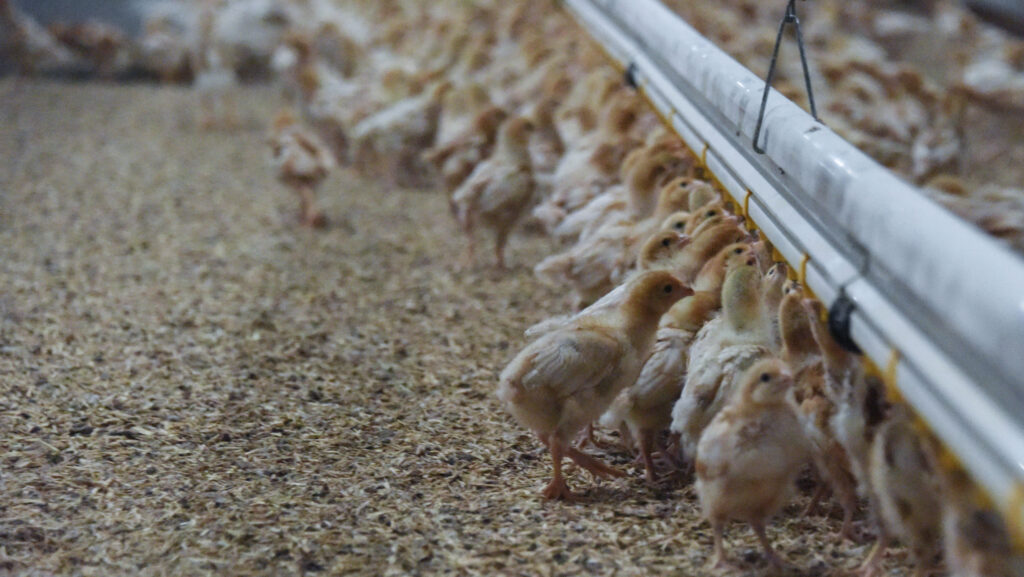Advice on using water vaccination for broilers and layers
 © Elanco
© Elanco Vaccination remains one of the tried and tested ways to reduce the risk of production losses in flocks from rising disease challenges.
Pathogens can have a devastating impact on farms, with both broiler and egg layer producers commonly using vaccination to maintain good health in their birds.
The most recent version of the Lion Code has sharpened focus in this area, with the new requirement that salmonella vaccines must be administered by a suitably trained person.
See also: Advice on efficient and safe drinking water systems for poultry
Poultry Health Services veterinary director Sara Perez and Elanco Animal Health layer business manager Jeremy Marsh share their insights on how producers can maximise results when vaccinating flocks via drinking water.
What is the best way to store vaccines?
Sara says poultry vaccines should have their own dedicated fridge separate from other animal health products and food for human consumption, with plenty of space for the vials.
For example, if pig vaccines were stored in the same fridge, this could pose an increased risk of salmonella through cross-contamination.

© Elanco
On taking delivery of the vaccine, she advises immediately writing the batch number and expiry date in the medicine book.
This saves time later and is a good way to check the vaccines will be in date when they are intended for use.
“Even vets and manufacturers have been known to make the odd mistake,” she says.
Jeremy advises storing the vaccine at 2-8C. “The farm manager should be responsible for checking and recording the temperature on a daily basis.
Regularly opening and closing the door will lead to fluctuations in temperature, which is not good for the vaccine,” he says.
Products should be stored on the middle of the shelf, as the back can often have much lower temperatures than other parts of the fridge, he adds.
How should poultry houses be prepared for vaccination?
“Firstly, switch any sanitation chemical off at least 24 hours before giving any vaccine through the water system,” says Sara.
She advises raising the drinker lines in the house and draining them of residual water before starting to mix up the vaccine.
Birds should not go more than an hour without water, so careful planning is key. Make sure the birds are kept calm by turning the lighting down and closing any windows, she adds.
Jeremy says: “Lifting the water lines also means the birds will build up a slight thirst and will be much more likely to drink the vaccine when the water lines are lowered [again].”

© Elanco
He says it is key to know the volume capacity of the system, so the correct amount of vaccine solution can be mixed, ideally to be drunk in three hours.
If the vaccine is gone within one hour, it is likely not every bird will have had a chance to drink it.
Using automatic flushing systems can make the process of priming lines much quicker and easier, Sara says.
On some farms where there may be a lot of houses or not enough staff, corners may get cut and the take-up of the vaccine is likely to be poorer.
How should the vaccine be prepared?
Vaccine preparation should take place in a clean and dedicated area where there will be no risk of contamination, Jeremy advises, adding that the operator must wear disposable gloves.
“Create a solution that reflects how much water the birds will drink over a three-hour period. Use a water buffer, which will have a blue dye [so the vaccine can be tracked through the system].
“This also protects the vaccine against the effects of chlorine and heavy metals in the water,” he says.
“The live vaccine usually comes as a freeze-dried pellet within a vial. Open the vial under the water so that the pellet is drawn out and into the water.
“Rinse the vial in the solution at least three times until all the vaccine is out.”
Sara recommends putting paper towel on the surface being used to prepare the vaccine.
She says this will ensure the vial only touches the paper and not the counter top, which may have contamination or disinfectant on it.
If de-ionised water is chosen for mixing the solution, make sure it is not the sort used for domestic irons or cars. These can have descaling agents in them that will be harmful to the vaccine.
Once the vaccine is properly mixed using a dedicated whisk, the lines should be primed with the vaccine solution using the dosing system, says Jeremy.
“Cover the vaccine container to prevent further contamination,” he says, “Let water flush through the raised drinker lines until the blue dye of the vaccine solution is seen at the end of the line.
“Once all lines are primed with vaccine, lower the lines and let the birds drink.”
How do you know the flock has taken the vaccine correctly?
Sara advises checking the birds’ tongues about four hours after the vaccine has been administered.
“If applied correctly, every bird should have a blue tongue,” she says, adding that for a more in-depth analysis, blood tests can be conducted two weeks after the vaccine to assess the level of antibodies.
Alternatively, PCR tests (using cloacal or tracheal swabs) can be used to ascertain the presence of the vaccine.
The appropriate sampling method depends on how much information is desired and how long after the vaccine has been given that the sample is taken.
Vaccines can be very costly, so take care of them and administer them properly, says Jeremy.
“Making sure that all steps are being followed and the intended results are being achieved are really important.
“Otherwise, farmers can find themselves wasting money and leaving birds without the protection they need.”
Five mistakes to avoid when giving a water vaccination
- Filling empty lines while they are down at bird height can lead to airlocks in the system. If water remains in the end of the lines, there will be a proportion of birds that do not get dosed with vaccine.
- Accidentally mixing different vaccines. Some labels look very similar and if there are several vaccines in the fridge, these can be easily confused.
- Not using a dedicated vaccine container to mix the solution. Buckets or pipes that have been used to hold disinfectants are likely to harm or even kill the live vaccine.
- Mixing vaccine solution on areas likely to be contaminated with pathogens or disinfectant, such as the floor.
- Incorrectly calculating the amount of water birds are drinking can result in the vaccine being drunk too quickly, or not all birds getting access to the vaccine in the allocated time. If a flock takes longer than four hours to drink, the vaccine will have started to die off before it reaches the birds.
Source: Jeremy Marsh and Sara Perez
